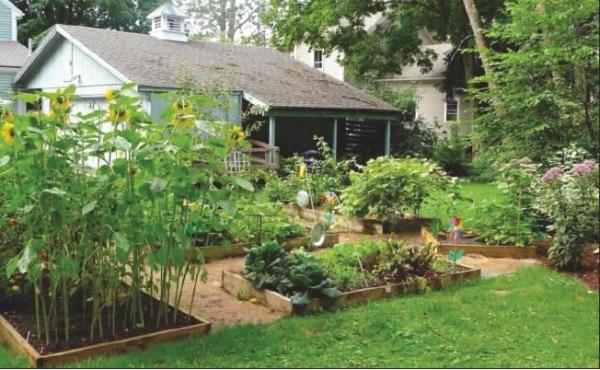Gardening Planning in January
The backyard garden in January is usually not much to look at. In fact, for most of us, the start of the new year is not really a time when we are thinking about gardening at all. That’s reserved for a little later in the year, about March, when the threat of cold or ice and frost has gone, and the promise of summer’s warmth is just around the corner.
However, for beginners and veteran gardeners alike, January is a great time to start planning a garden. As opposed to figuring everything out on the fly, starting early allows ample time for finding the right plants and getting a good line on soil, mulch, and all the other stuff that’ll make the garden more of a success but also less labor-intensive. Then, for beginners, there’s coming up with a good plan for why and how to plant what when and where. While we gardening old-timers will be trying to figure out where to expand our gardens, or what new veggies to grow.
For those vowing to grow a garden this year, it’s time to start thinking about it, and I am going to try to provide some helpful little insights; tips and trick of a long-time gardener you might call it.
One of the things I learned early on in my gardening career is that the more time spent prepping the garden beforehand, the less time required with the burdensome business of weeding and watering. So, I always make myself a handy little January garden to-do list.
Start by finding out what USDA zone you live in, and then consider what plants grow well in that zone and when that happens. We in central Texas are in USDA zone 8 so tomatoes that might not fare well in a Minnesota (they are USDA zones 3 and 4) April, will be warm, happy, and growing strong in our Texas gardens. On the other hand, cool weather crops, think about the various members of the cabbage family for example, will not like late Texas springtime at all. They will bolt in out hotter weather, that means they will go to seed and become bitter tasting.
Find the plants that are best suited for our zone and master those first. For the beginner I recommend five or ten different crops is a good number to start with. We veteran gardeners just can’t help ourselves and we will keep adding and adding to our gardens. In 2018 through 2019 I have grown a total of 27 different fruits and vegetables and some 50+ different varieties of those – and for some gardeners that is a considered a small number! I recommend that any gardener skip growing most items from seeds and start with transplants. Look for heirloom and organic varieties from local suppliers or nurseries for your plants. These will be much more likely to be suitable to our zone, and being from local providers, they’ll be adapted to the area already. A free downloadable list of recommended varieties for our area is available at www.GardeningAustin.com.
It’s January, so there is plenty of time to do the homework and choose wisely, and there is plenty of time to get the details about growing the plants that make the cut. But if you are planning to grow from seed this year you need to get your seeds ordered and started this month to ensure your seedlings will be ready for transplanting into the garden when the time arrives.
For beginning gardeners especially, it is very easy to lose track of all that is going on in the garden. Peas should be planted before peppers and all that jazz. Likewise, different vegetables and even different varieties of similar vegetables should be planted in particular sequences (crop rotation) in order to keep soil lively and rich, as well as to avoid pests and diseases.
The only way to keep track of these types of things is to write it down, that is, to plan well. Successful cultivators schedule and map out the garden so that something is always being harvested and something new is always being planted. This is how to avoid having 150 cucumbers showing up all at once in June or July, but none the month before or after.
Knowing what plants are going to work well, it’s time to start figuring out the timing so that they perform their best. It’s January and cold outside, which is the perfect weather for plotting out planting sequences. I have been keeping a gardening notebook for years in which I map out where each item will be planted, when it goes in, when to pull it out, and what goes in that spot next. I also note which varieties did particularly well or not so that I can better plan for the next garden season.
One thing experience has taught me is that it is best to avoid sticking the garden in the back corner of the yard because that’s the best place if you want to forget about it. Instead, consider designing a garden that’ll work in high traffic areas around the house, where you’ll constantly be passing it to notice the lettuce needs a little water, or a bit of weeding is as easy as bending down on the regular route. Using garden beds around patios and/or containers on a balcony is a much better idea than stuffing the garden in no man’s land. Instead, when gardens are part of the spaces we commonly use, they’ll be much easier to care for. The easier gardens are to care for, the more likely they are to be well-looked after. Also, if the garden is just a few steps from the kitchen, you will be more likely to use fresh garden bounty of both veggies and herbs, in your daily cooking.
Rather than making a rowed garden off the beaten track, map out a plan for gardens that go next to sidewalks, that decorate patios, and that use balcony rails for garden stakes. Looking out the windows in January provides a good assessment of the places we commonly see and use.
One final thought for those of you planning to grow from seed this year. Order your seeds now! Look online or peruse paper seed catalogs for what you might plant this spring. Ordering early will increase your chances of getting your hands on seeds that might have lower availability. Perhaps you might even try some new varieties you have never grown before in this year’s garden. If you have young people in your life, growing things from seed is a great way to get them interested in gardening. Start dreaming now.
In permaculture, the accepted modus operandi is to spend ample time planning before working up a sweat. The idea is to work smart before rather than to work hard later. January then, long before any shovels hit soil or seeds go in the ground, is a great time to start gardening dreaming. Do the mental work in the winter, and that’ll make the spring and summer so much more bountiful then you can possibly guess.



